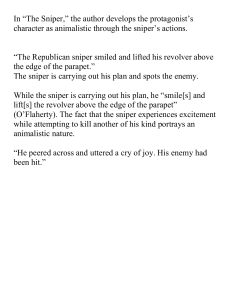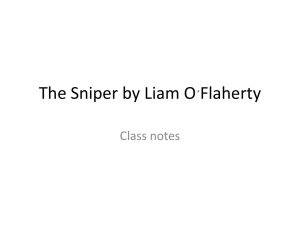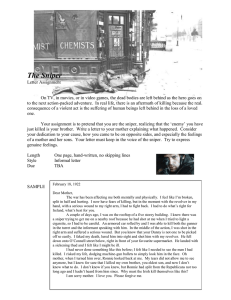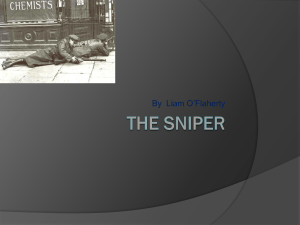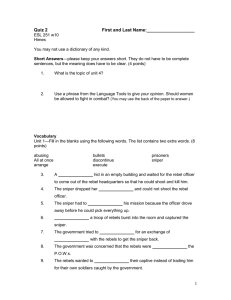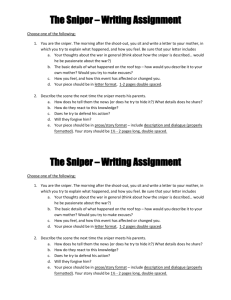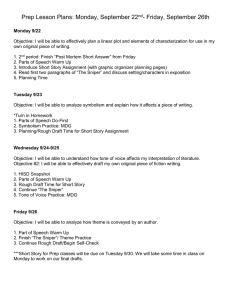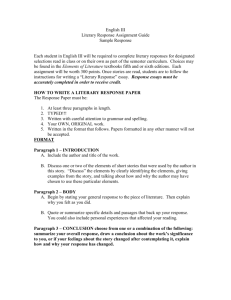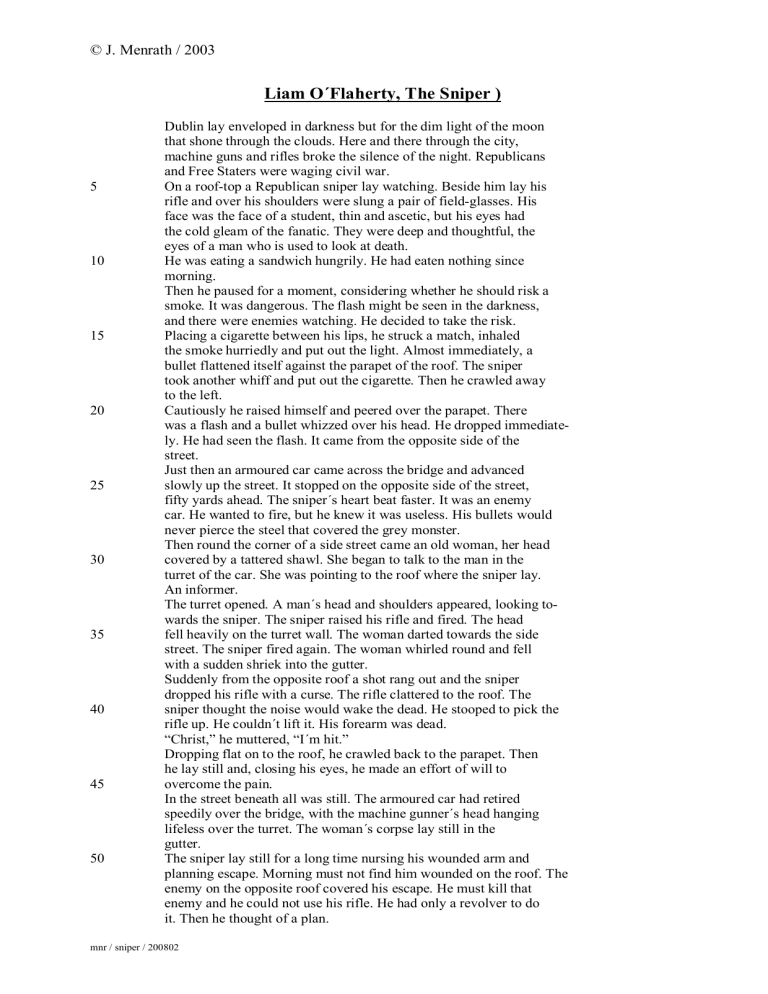
© J. Menrath / 2003 Liam O´Flaherty, The Sniper ) 5 10 15 20 25 30 35 40 45 50 Dublin lay enveloped in darkness but for the dim light of the moon that shone through the clouds. Here and there through the city, machine guns and rifles broke the silence of the night. Republicans and Free Staters were waging civil war. On a roof-top a Republican sniper lay watching. Beside him lay his rifle and over his shoulders were slung a pair of field-glasses. His face was the face of a student, thin and ascetic, but his eyes had the cold gleam of the fanatic. They were deep and thoughtful, the eyes of a man who is used to look at death. He was eating a sandwich hungrily. He had eaten nothing since morning. Then he paused for a moment, considering whether he should risk a smoke. It was dangerous. The flash might be seen in the darkness, and there were enemies watching. He decided to take the risk. Placing a cigarette between his lips, he struck a match, inhaled the smoke hurriedly and put out the light. Almost immediately, a bullet flattened itself against the parapet of the roof. The sniper took another whiff and put out the cigarette. Then he crawled away to the left. Cautiously he raised himself and peered over the parapet. There was a flash and a bullet whizzed over his head. He dropped immediately. He had seen the flash. It came from the opposite side of the street. Just then an armoured car came across the bridge and advanced slowly up the street. It stopped on the opposite side of the street, fifty yards ahead. The sniper´s heart beat faster. It was an enemy car. He wanted to fire, but he knew it was useless. His bullets would never pierce the steel that covered the grey monster. Then round the corner of a side street came an old woman, her head covered by a tattered shawl. She began to talk to the man in the turret of the car. She was pointing to the roof where the sniper lay. An informer. The turret opened. A man´s head and shoulders appeared, looking towards the sniper. The sniper raised his rifle and fired. The head fell heavily on the turret wall. The woman darted towards the side street. The sniper fired again. The woman whirled round and fell with a sudden shriek into the gutter. Suddenly from the opposite roof a shot rang out and the sniper dropped his rifle with a curse. The rifle clattered to the roof. The sniper thought the noise would wake the dead. He stooped to pick the rifle up. He couldn´t lift it. His forearm was dead. “Christ,” he muttered, “I´m hit.” Dropping flat on to the roof, he crawled back to the parapet. Then he lay still and, closing his eyes, he made an effort of will to overcome the pain. In the street beneath all was still. The armoured car had retired speedily over the bridge, with the machine gunner´s head hanging lifeless over the turret. The woman´s corpse lay still in the gutter. The sniper lay still for a long time nursing his wounded arm and planning escape. Morning must not find him wounded on the roof. The enemy on the opposite roof covered his escape. He must kill that enemy and he could not use his rifle. He had only a revolver to do it. Then he thought of a plan. mnr / sniper / 200802 © J. Menrath / 2003 55 60 65 70 75 80 85 90 95 100 Taking off his cap, he placed it over the muzzle of his rifle. Then he pushed the rifle slowly upwards over the parapet, until the cap was visible from the opposite side of the street. Almost immediately there was a report, and a bullet pierced the centre of the cap. The sniper slanted the rifle forward. The cap slipped down into the street. Then catching the rifle in the middle, the sniper dropped his left hand over the roof and let it hang, lifelessly. After a few moments he let the rifle drop to the street. Then he sank to the roof, dragging his hands with him. Crawling quickly to the left, he peered up at the corner of the roof. His ruse had succeeded. That other sniper, seeing the cap and rifle fall, thought that he had killed his man. He was now standing before a row of chimney pots, looking across, with his head clearly silhouetted against the western sky. The Republican sniper smiled and lifted his revolver above the edge of the parapet. The distance was about fifty yards – a hard shot in the dim light, and his right arm was paining him like a thousand devils. He took steady aim. His hand trembled with eagerness. Pressing his lips together, he took a deep breath through his nostrils and fired. He was almost deafened with the report and his arm shook with the recoil. Then when the smoke cleared he peered across and uttered a cry of joy. His enemy had been hit. He was reeling over the parapet in his death agony. He struggled to keep his feet, but he was slowly falling forward, as if in a dream. The rifle fell from his grasp, hit the parapet, fell over and then clattered on to the pavement. Then the dying man on the roof crumpled up and fell forward. The body turned over and over in space and hit the ground with a dull thud. Then it lay still. The sniper looked at his enemy falling and he shuddered. The lust of battle died in him. He became bitten by remorse. The sweat stood out on his forehead. Weakened by his wound and the long summer day of fasting and watching on the roof, he revolted from the sight of the shattered mass of his dead enemy. His teeth chattered, he began to gibber to himself, cursing the war, cursing himself, cursing everybody. He decided to leave the roof now and look for his company commander, to report. Everywhere around was quiet. There was not much danger in going through the streets. When the sniper reached the street, he felt a sudden curiosity as to the identity of the enemy sniper whom he had killed. He wondered did he know him. Perhaps he had been in his own company before the split in the army. He decided to risk going over to have a look at him. In the upper part of the street there was heavy firing, but around here all was quiet. The sniper darted across the street. A machine-gun tore up the ground around him with a hail of bullets, but he escaped. He threw himself face downwards beside the corpse. The machine-gun stopped. Then the sniper turned over the dead body and looked into his brother´s face. (about 1120 words) mnr / sniper / 200802 © J. Menrath / 2003 Annotations l. 17 l. 18 l. 24 l. 30 l. 37 l. 50 l. 58 l. 65 l. 75 l. 89 l. 101 parapet whiff armoured tattered gutter to nurse report ruse recoil to gibber to oneself to dart low wall along the edge of the roof, to protect the roof a smell you notice for a short time only protected by metal old and worn place close to the edge of the road to care for somebody who is sick or wounded sound of a gun being fired Trick sudden movement backwards, esp. of a gun being fired to speak in a way difficult to understand, esp. in fear to move quickly and suddenly Tasks 1. Zum Textverständnis What is the story about? Give a short summary of the story. 2. Zum Aufbau What different sections does the story fall into? Give proof of your findings in a coherent text and use appropriate literary terms for some structural units. 3. Zur Textanalyse und Form A What atmosphere does the author convey to the reader? Give concrete examples. B Characterise the sniper. What do we get to know about his feelings? C Describe the point of view used in the story very briefly. 4. Textübergreifende Aufgabe If you consider the historical background against which the story is to be seen, can you imagine any relationship to Bernard MacLaverty´s novel “Cal”? Good luck! mnr / sniper / 200802 © J. Menrath / 2003 Model Answers Task 1 The short story “The Sniper” by Liam O´Flaherty deals with a split in the Irish army during the Civil War. Heavy fighting has come up in Dublin between radical Republicans opposing the idea of the Free State (like the sniper) and those people who accept the dominion status of Ireland after the Anglo-Irish Treaty of 1922 (the Free-Staters). Killing some “enemies” – among them even his own brother – the sniper experiences the cruelty and senselessness of that war and shows feelings of Irish togetherness when he is forced to look into his dead brother´s face. (96 words) Task 2 As to the structure of the short story you can easily recognise typical aspects of a short story. In the exposition (ll. 1-9) O´Flaherty introduces the reader to the situation, the main characters and the setting. He also sets the atmosphere of war so that the reader is involved in the mood of the time of the Civil War. An open beginning (“Dublin lay enveloped in darkness …”) is characteristic in that it catches him from the start. The main part of the story (ll. 10-84) comprises details of the difficult political situation of that time with strikes and counterstrikes following one another uninterruptedly. When the sniper succeeds against his immediate opponent by way of a trick, the story seems to have reached its climax (l. 67f.). That experience marks the turning-point in the story since human feelings are coming up in him when the sniper watches the dead body fall from the other roof-top (ll. 81ff.). The ending (ll. 85-104), however, comes as a surprise. The sniper shows human feelings in his curiosity to look at the dead body, and this curiosity makes him look into his brother´s face. mnr / sniper / 200802 © J. Menrath / 2003 Task 3a The atmosphere in “The Sniper” is characterised by one of the darkest chapters in Irish history, i.e. Civil War. Therefore, the reader is closely confronted with the succession of bullets and machine guns being fired, and armoured cars driving in the streets of Dublin. On the one hand scenes of action and reaction to heavy firing are alternating very fast. O´Flaherty´s choice of words underlines the effect in a very impressive way, with many onomatopoeic words appearing in the story (such as “flash” (l. 21), “whizzed” (l. 21), “pierce the steel grey monster” (l. 28), “clattered”(l. 39), “crumpled up” (l. 81), “dull thud” (l. 83) or “shattered mass” (l. 88). On the other hand there is a strong contrast to words of silence used as well. The author emphasises the stillness noticeable in pauses of shooting or in dead bodies lying “still” (l. 83) on the ground. Silence is always tricky in times of war, and so the word “still” almost acquires an ambiguous meaning. All in all, the reader notices a rather serious and sinister atmosphere, only at the end of the story a ray of hope does shine through. Task 3b The narrator in the story calls the sniper “young”, “ascetic” and “fanatic” in the exposition. He is a soldier who has to carry out his orders of killing his enemies in cold blood, without any feelings of guilt or remorse. To show pain is forbidden. The sniper plans his actions minutely and is presented by the narrator as a watchful and diligent observer of the opponents´ next steps. Being very courageous and obedient, he takes his own death into account in order to fulfil his tasks. After being hit by the enemy sniper, he has to think of a trick to be successful at last. Consequently, feelings of superiority are coming up, he can smile again (l. 69), is eager to kill the other sniper (l. 72) and utters “a cry of joy” (l. 76f) after his success. Yet after that immediate experience of death he shudders, has lost all the eagerness for another fight, and is “bitten by remorse” (l. 84f). At the end of this inner process of revolt (l. 87) the protagonist´s conscience wins, he regrets being involved in that war (“cursing the war, cursing himself, cursing everybody” (l. 89f.)) and feels guilty. The author O´Flaherty has the sniper look into his brother´s face at the end of the story which is certainly the most effective ending you can imagine. mnr / sniper / 200802 © J. Menrath / 2003 “The Sniper” can, therefore, rightly be called a story of initiation because a young man is introduced to the world of adults when he is confronted with the implications of his cruel actions in war. Task 3c The perspective is that of a 3rd person narrator. The point of view is limited because the narrator confines himself to the protagonist´s point of view. That is to say that he limits his narration to what is experienced, thought, and felt by the sniper who is in the centre of attention in the action and thus provides the “centre of consciousness”. The narrator knows exactly what the protagonist is going to do next and observes him with a “camera-eye” technique. Consequently, the reader feels deeply with the protagonist and his situation. Who else but an omniscient narrator could know that “his [the sniper´s] eyes had the cold gleam of the fanatic” (l. 8), that they are “the eyes of a man who is used to look at death” (l. 9), and that “he must kill that enemy” (l. 53f). The text abounds in countless examples of the Republican´s thoughts and feelings, almost culminating in self-denial. Task 4 As to its relationship with Bernard MacLaverty´s novel “Cal”, we can recognise quite a number of similarities. For example, both literary pieces deal with the fight for political purposes and the harsh realities of war. Cal´s personal relationship to Marcella is overshadowed by his involvement in IRA actions that have led to the murder of her husband. Consequently, Marcella will never be able to respond to his signs of love. Cal, on the other hand, has scruples of showing his real identity and will never succeed in courting her effectively. However, he wants to leave the IRA, take responsibility, and lead a decent life. The Republican, although called “sniper” only, is also an individual who develops human qualities from his actions. So the two works can indeed be compared. Yet there are differences as well. The novel presents the political troubles in Northern Ireland during the 1970s whereas the short story deals with the troubles in Dublin after the Proclamation of the Free State in 1921. One question remains open at the end of the story: Will the sniper also take responsibility for his actions as Cal does at the end of the novel when he is almost relieved after his arrest by the police? mnr / sniper / 200802
